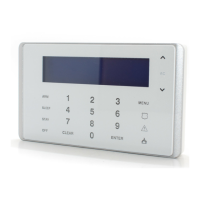
Do you have a question about the Paradox K656 Touch Sense and is the answer not in the manual?
Introduces the K656 Touch Sense LCD Keypad and its user-friendly navigation capabilities.
Lists and describes the main features of the K656 keypad, including its LCD screen and touch-sensitive keys.
Details the electrical and environmental specifications for the K656 keypad, including voltage and temperature range.
Explains how the keypad uses beep tones for confirmation and rejection of commands.
Provides instructions on how to set the system's time and date through the keypad menu.
Covers various user-configurable settings for the keypad, such as brightness, contrast, and scroll speed.
Describes the Confidential Mode where the keypad status and indicator lights are not displayed.
Explains the function of programmable outputs (PGMs) and their role in system events.
Guides users on how to program specific zones to chime when opened or closed.
Details how to activate different types of panic alarms (police, medical, fire) using the keypad.
Explains how to access system command functions, requiring specific user codes or master access.
Allows users to view the status of individual areas within a partitioned security system.
Details the different arming modes: Arm, Force Arm, Stay Arm, and Instant Arm.
Explains the exit delay timer that allows time to leave the premises after arming.
Describes how to bypass specific zones before arming and how to recall bypassed zones.
Covers the use of dedicated buttons for quick system arming and other functions.
Explains how to arm and disarm the system using a physical keyswitch.
Covers Timed Auto-Arming and No Movement Auto-Arming features.
Details the entry delay timer that allows time to disarm the system upon entry.
Provides step-by-step instructions for disarming the system, including single and multiple areas.
Explains how the system displays and stores information about past alarms.
Instructions for changing the system master code for enhanced security and access.
Describes how to copy user settings, access controls, and area assignments between user codes.
Guides users on assigning custom labels to user codes for easier identification.
Explains how keypad buttons are used for entering letters and special characters.
Details the functionality of special keys like STAY, SLEEP, and ARM for text editing.
Covers the procedures for deleting existing user codes and programming new ones.
Outlines the general considerations and steps for adding new users and modifying their access.
Explains various user options like Master Feature, Duress, Bypass, Arm Only, Stay/Instant, and Force Arm.
Details options related to access control, including card access, extended unlock periods, and scheduling.
Instructions on how to access and navigate the trouble display menu to identify system issues.
Lists various trouble categories (System, Communicator, Module, etc.) and their specific codes.
Explains how to view the history log to review user-initiated actions and system events.
Describes the LED and auditory feedback for Full/Force and Stay arming states.
Details feedback for other system functions like PGM activation.
Instructions for calling and interacting with the VDMP3 voice module for system control.
Guides on setting up SMS notifications for system events and configuring phone numbers.
Procedures for testing the burglar and fire alarm functionalities of the system.
Recommendations for system maintenance, including battery replacement.
Steps for performing a comprehensive system test with the monitoring station.
Explains the behavior of standard and delayed fire zones during an alarm event.
Provides tips and recommendations for home fire safety and hazard prevention.
Discusses home fire warning systems and their components.
Describes how the system responds to a burglar alarm breach.
Displays the standard characters available for the Hebrew language input.
Displays the standard characters available for the Russian language input.
Displays the standard characters available for the Greek language input.
Lists special characters for Hebrew input, mapped to keypad entries.
Lists special characters for Russian input, mapped to keypad entries.
Lists special characters for Greek input, mapped to keypad entries.